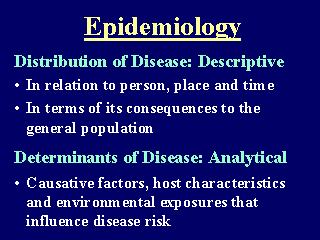|
|
|
|
front |1 |2 |3 |4 |5 |6 |7 |8 |9 |10 |11 |12 |13 |14 |15 |16 |17 |18 |19 |20 |21 |22 |23 |24 |25 |26 |27 |28 |29 |review |
 |
First, we will review the definition and objectives of general
epidemiology. Descriptive epidemiology is the study of the distribution of disease in populations. Incidence and prevalence rates of disease are often presented in relation to person, place and time, and in terms of their consequences to the general population. Thus, descriptive epidemiology characterizes the burden of disease in a population. Analytical epidemiology is the study of the determinants of disease. These include causative factors (i.e., infectious agents), host characteristics (i.e., susceptibility genes) and environmental exposures (i.e., lifestyle habits) that influence the risk of developing the disease. Relative risks and odds ratios are evaluated for potential determinants of the disease. Thus, analytical epidemiology characterize the risk factors for disease in populations. |
|
|
|
|
front |1 |2 |3 |4 |5 |6 |7 |8 |9 |10 |11 |12 |13 |14 |15 |16 |17 |18 |19 |20 |21 |22 |23 |24 |25 |26 |27 |28 |29 |review |